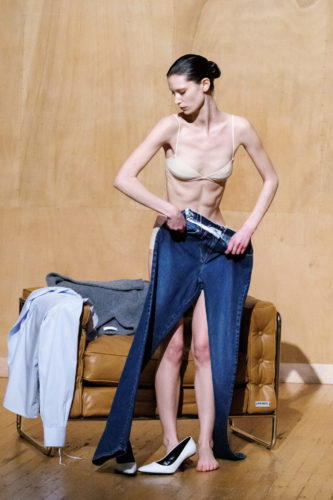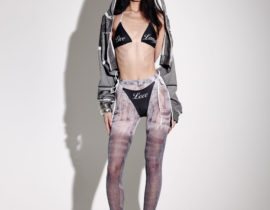









Dear Shaded viewers,
At only 26, Belgian designer Julie Kegels is not only establishing her brand but with it her design sensibility and style. Through her FW25 collection, she explored the notion that dressing is not only about the clothes but who you are and who you can become through sartorial exploration. Clothing is integrated with our surroundings and our interior worlds, it evolves with the times and has huge influences on our societies, therefore it is an essential element of our everyday. Kegels’ inspiration for this collection, a step forward in her design and brand maturity, came from the 1980 book “Executive Style” by Judith Price. Price wrote, “Style comes only from recognising your best traits and showcasing them with taste and flair in everything you do” – so what is Julie Kegels’ style?
In the backdrop of the wood clad walls of Salle Cotot, the 17th Arrondissement Concert hall designed by Auguste Perret in 1926, her clothing became part of the furniture. She proposed an inventive take on 20th century design, particularly honing in on the 1980s and dressing for corporate success. A first model came onto the stage, dressing herself in the opening look: a comfortable, office casual grey sweater, unbuttoned blue shirt and jeans. The look was waiting on a chair designed by Kegels with Belgian furniture label HARMO that blended in with the space perfectly, found printed on later looks.
As the show continued, we saw youthful influences integrated with a mature office wear sensibility. Almost matching sets of mismatched denim and suiting were cut short, disrupted with slight exposed midriff or tucked in shirts. Slouchy silhouettes for tops held their shape, cinched at the waist often with their own belts. Fleece blankets were wrapped around the body and the wooden textures echoing those of the concert hall were printed on shirts and pants. While shoulders were bold and sharp, textures remained soft and inviting like velvet added to knitwear or tufted and cut into a dress with a long train. Delightfully pastel silk dresses draped, cut with angular corners. Actually they were deconstructed suits that introduced a sheen through exposed inner linings.
A standout piece was a dress carved and polished, made entirely from wood veneer shaped around the body as if it were furniture itself.
The final look of the collection was a repetition of the first, except with each garment connected to create a jumpsuit that slipped off with ease through a zipper down its back. Presenting the models interaction with the clothing punctuated the conceptualisation in Kegel’s collection.
Later,
Eliya



